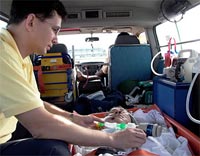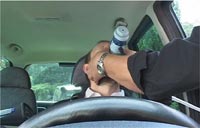Oxylator automatically maintains adequate ventilation
for each patient through a patented pressure and flow
sensing system that allows for passive exhalation.
Unique technology guides the care giver to provide
proper airway management.
Oxylators®
are patient-responsive, oxygen-powered
resuscitation/inhalation devices intended
to provide emergency ventilatory support for patients
weighing more than 10 kg (22 lbs). Utilizing
patented technology,
Oxylators® are simple, safe and effective and give the
care giver utmost
flexibility
in airway
management during emergencies and attended short-term
ventilation.
The Food and Drug Administration (FDA) classifies
Oxylators® in Class II (two) under the Product Code 73
BTL. The devices meet the performance standards as set
out in ASTM F920-85 and ISO 8382. The
Oxylator® is a
Class I (one) device a referenced in JAMA
'Guidelines for Cardiopulmonary Resuscitation and
Emergency Cardiac Care', American Heart Association
(AHA).
Oxylators® are patient responsive resuscitators
that incorporate two distinct
functional elements during a ventilatory cycle.
The first, during the inspiratory phase
of a ventilatory cycle, is a selectable pressure
limit which initiates the second, a
passive expiratory phase which is flow
controlled.
The Oxylator® will not start a new
inspiratory cycle until exhalation is complete. That
point is reached between 2-4 cmH2O of
PEEP in automatic or continuous mode, and at base line
in manual mode. This eliminates 'stacked' breaths and
their associated complications. The end of the
expiratory phase then triggers the next inspiratory
cycle, hence the new inspiratory phase is flow
triggered.
The design of the Oxylator® provides various unique
features some of which can otherwise be found only on
higher priced ventilators. In the hands of a trained
caregiver administering cpr, Oxylators® are
resuscitation management systems.
The Oxylator® was designed to provide utmost
flexibility, safety and effectiveness by combining all
the features of a resuscitator and a first response
ventilator in a small, handheld unit.

Specifications:
²allows the caregiver to use both hands to maintain a better mask
seal and reduces fatigue when used in its 'automatic
mode'.
²when the device is used simultaneously during chest
compressions, it automatically synchronizes the
cycling rhythm to the compressions administered,
providing safe and effective two person cpr.
 ²minimal PEEP is maintained (< 4 cmH2O)
when used in automatic mode.
²minimal PEEP is maintained (< 4 cmH2O)
when used in automatic mode.
²allows the caregiver to switch to manually activated
ventilatory cycles if confronted with patients that
demonstrate abnormal lung compliance.

²provides inhalation function when resuscitation is no longer
required. This can be overridden automatically if
resuscitation needs to be re-initiated.
²simple construction allows the user to disassemble the top and
bottom components instantly - without tools - to
ensure proper cleaning and disinfection of the
system.
²
the trained caregiver can monitor and detect deterioration or
improvement of a patient’s lung condition from
cycling rate changes.
²a disposable viral-bacterial filter can be inserted into the patient
connection of the device, if desired.
²the Oxylator® eliminates the potential of 'stacked'
breaths, or gradual increase in PEEP levels which
may occur with time/volume cycled systems. Its
expiratory phase allows for passive, unassisted
exhalation.
²Minute Volume will always be maintained when used in automatic mode,
regardless of pressure settings or lung compliance.
²during the ventilatory cycle, the system always
maintains a positive pressure in the airway, unless
a negative pressure is initiated by the patient’s
own effort at which point it allows the patient to
satisfy his or her own 'demand'.
²due to its patented technology, the Oxylator® will
automatically cycle with a patient’s own rhythm and
wastes no time in 'detecting' failure of a patient’s
own inspiratory effort.
²
no oxygen is wasted to power the device.
²malfunction is reduced to a minimum since the
Oxylator® utilizes ONLY ONE moving component which
'floats' as it cycles.